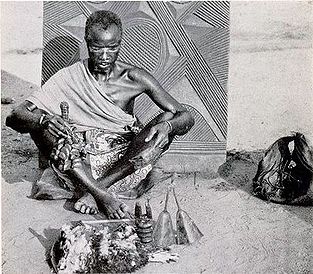@Captain_Crunch
The indigenous religious beliefs and practices of African peoples include various traditional religions. While generalizations of these religions are difficult, due to the diversity of African cultures, they do have some characteristics in common. Generally, they are oral rather than scriptural, include belief in a supreme being, belief in spirits and other divinities, veneration of ancestors, use of magic, and traditional medicine. The role of humanity is generally seen as one of harmonizing nature with the supernatural.
While adherence to traditional religion in Africa is hard to estimate, due to syncretism with Christianity and Islam, practitioners are estimated to number over 100 million, or at least 10 percent of the population of the continent. African diasporic religions are also practiced by descendants of Africans in the diaspora in the Americas such as Candomble, Umbanda, Quimbanda in Brazil, Santeria in Cuba and the United States, Lucumi in the Caribbean and Vodun in Haiti and the United States.
Terminology
African traditional religion, African traditional religions, Indigenous African religions are all common terms used to discuss the subject of indigenous faiths found within Africa. Each term is debated among scholars. Some challenge the word "traditional" and prefer "indigenous" since traditional can also include traditional African Islam and Christianity, which in some cases date back to the 4th century BCE and are established traditions in African societies. Some, such as Mbiti, contend that while using the singular "religion" a plural understanding is needed. Others suggest that these thousands of "religions" are only differing expressions of the same basic "religion." The argument posited is that a centralized structure of rituals and beliefs run the entirety of the African continent. Some suggest this is problematic as there is no "genetic" relationship between these plural beliefs to create ideological homology, and the observed similarities can subjectively also be found outside of Africa.
Classification and statistics[edit]


An early 20th century Igbo medicine man in Nigeria, West Africa
Adherents.com lists African Traditional & Diasporic as a major religious group, estimating some 100 million adherents. They justify this combined listing of traditional African and African diasporic religions, and the separation from the generic primal-indigenous category by pointing out that:
the "primal-indigenous" religions are primarily tribal and composed of pre-colonization peoples. While there is certainly overlap between this category and non-African primal-indigenous religious adherents, there are reasons for separating the two, best illustrated by focusing specifically on Yoruba, which is probably the largest African traditional religious/tribal complex. Yoruba was the religion of the vast Yoruba nation states which existed before European colonialism and its practitioners today – certainly those in the Caribbean, South America and the U.S. - are integrated into a technological, industrial society, yet still proclaim affiliation to this African-based religious system. Cohesive rituals, beliefs and organization were spread throughout the world of Yoruba (and other major African religious/tribal groups such as Fon), to an extent characteristic of nations and many organized religions, not simply tribes.
Practitioners of traditional religions in Sub-Saharan Africa are distributed among 43 countries, and were estimated to number over 100 million, although the largest religions in Africa are Christianity and Islam.

 May #LWO wins this tanking party in June.
May #LWO wins this tanking party in June.






